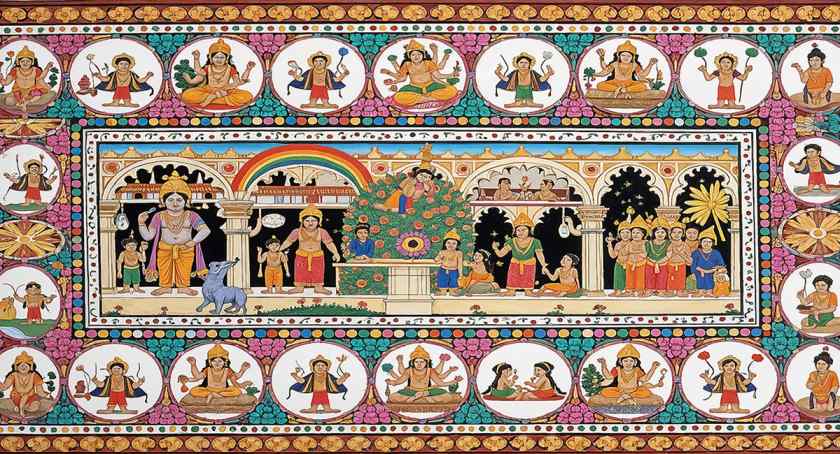Pattachitra Art on Fabric
Pattachitra, one of India’s most ancient and intricate art forms, originates from the culturally rich state of Odisha. This traditional painting style, known for its detailed mythological narratives and vibrant colors, has evolved over centuries, adapting to new mediums beyond palm leaves and cloth scrolls. Among its modern adaptations, Pattachitra art on fabric has gained significant popularity, blending heritage with modern fashion and home decor. To provide insight into Pattachitra’s process, significance, and contemporary relevance, we examine its history and current uses on cloth in this blog.
The Origin and Evolution of Pattachitra Art
‘Pattachitra’ is developed from two Sanskrit words: ‘Patta,’ meaning cloth, and ‘Chitra,’ meaning picture. Historically, artists used this art form to depict mythological themes, folklore, and religious stories, especially those related to Hindu deities like Lord Jagannath, Krishna, and Radha. These paintings often served as religious offerings and storytelling tools in temples and households.
Traditionally painted on palm leaves or handmade cloth scrolls, Pattachitra artists, known as ‘Chitrakars,’ used natural dyes and pigments extracted from minerals, stones, and vegetables. The paintings featured complex detailing, elaborate borders, and vibrant hues, creating mesmerizing visual narratives. This beautiful art gave way to fabric with time, expanding its use beyond religious paintings and reaching a wider audience. Today, people celebrate Pattachitra on fabric for its artistry, eco-friendliness, and deep-rooted cultural symbolism.
The Process of Creating Pattachitra Art on Fabric
The creation of Pattachitra art on fabric follows careful steps, requiring precision, patience, and skill. Each handcrafted piece narrates a story through its elaborate motifs and intricate details. Here’s a look into the process:
Selection and Preparation of Fabric:
The base fabric is usually cotton or silk, chosen for its durability and smooth texture. Before painting, the fabric undergoes tamarind seed paste and natural gum treatment to enhance its stiffness and absorbency. This step ensures that the colors adhere well and maintain vibrancy over time.
Sketching the Design:
Artists use a fine brush or a charcoal pencil to outline the intricate designs, often depicting scenes from Hindu mythology, nature-inspired motifs, or geometric patterns. These outlines serve as a guide for the painting process. The complexity of the design depends on the theme, with some pieces requiring weeks to complete.
Natural Color Preparation:
Unlike modern chemical dyes, artisans derive traditional Pattachitra colors from natural sources and carefully prepare the pigments to ensure longevity and richness. Some standard natural colors include:
- White – Extracted from conch shells
- Black – Derived from burnt coconut shells
- Red – Made from powdered stones
- Yellow – Obtained from turmeric
- Blue – Extracted from indigo plants
These colors are mixed with natural gum to enhance their adhesion and durability on fabric. Using natural pigments preserves tradition and aligns with sustainable and eco-friendly art practices.
Painting and Detailing:
Artists apply the colors in layers, meticulously adding details and shading to create depth and vibrancy. Pattachitra’s characteristic features are its bold outlines and intricate patterns, which require immense skill and precision. The process involves multiple layers of painting, each adding definition and texture to the artwork. Once the painting is complete, it is left to dry and later ironed to set the colors, ensuring they remain intact for years.
Modern Adaptations of Pattachitra on Fabric
With a growing appreciation for sustainable and handmade art, Pattachitra on fabric has applications in various domains, including fashion, home decor, and accessories. This art form’s versatility has allowed it to integrate into contemporary lifestyles while preserving its authenticity seamlessly.
Fashion and Apparel:
Designers and textile enthusiasts have embraced Pattachitra to create stunning sarees, dupattas, stoles, and kurtas. The intricate motifs add an ethnic charm, making these garments perfect for festive occasions, cultural celebrations, and weddings. The handcrafted nature of these garments makes them exclusive, with no two pieces being identical.
Home Decor:
Today, artisans frequently employ Pattachitra art in home décor pieces like bedspreads, wall hangings, table runners, and cushion covers. These hand-painted pieces add a touch of tradition and sophistication to contemporary interiors. The detailed motifs and vibrant colors bring warmth and elegance to any space, making them sought-after collectibles.
Accessories and Handcrafted Items:
Pattachitra artists now showcase their designs on various accessories, including handbags, clutches, footwear, scarves, and even jewelry boxes. These accessories serve as unique statement pieces for art lovers, allowing them to carry a piece of heritage wherever they go. Fusing traditional art with modern utility has made Pattachitra integral to sustainable fashion and lifestyle products.
Why Pattachitra on Fabric Stands Out?
The resurgence of handcrafted, sustainable, and culturally rich art forms has propelled Pattachitra on fabric into the limelight. Here’s why it continues to captivate art connoisseurs and fashion enthusiasts:
- Handcrafted Excellence – Each piece is hand-painted individually, making it a unique masterpiece.
- Eco-Friendly Appeal – Made using natural dyes and sustainable materials, Pattachitra on fabric aligns with eco-conscious fashion trends.
- Cultural Significance — Wearing or displaying Pattachitra art preserves and promotes India’s rich artistic heritage.
- Enduring Beauty — Pattachitra’s elaborate patterns and brilliant hues guarantee that it will always be in vogue.
Final Thoughts
Pattachitra art on fabric is more than just a visual delight; it bridges tradition and modernity. Whether worn as a saree, used as a home decor piece, or carried as an accessory, this intricate artwork tells a story of heritage, craftsmanship, and passion. By embracing and supporting this timeless art form, we celebrate India’s artistic legacy and contribute to the livelihoods of skilled artisans keeping this tradition alive.
The charm of Pattachitra lies in its ability to adapt while preserving its essence. Pattachitra remains evidence of India’s artistic brilliance as contemporary fashion and design evolve, effortlessly weaving history into modern lifestyles. So, the next time you come across a beautifully hand-painted Pattachitra fabric, remember that you are not just looking at a piece of clothing or decor—you are witnessing centuries of tradition woven into art.


